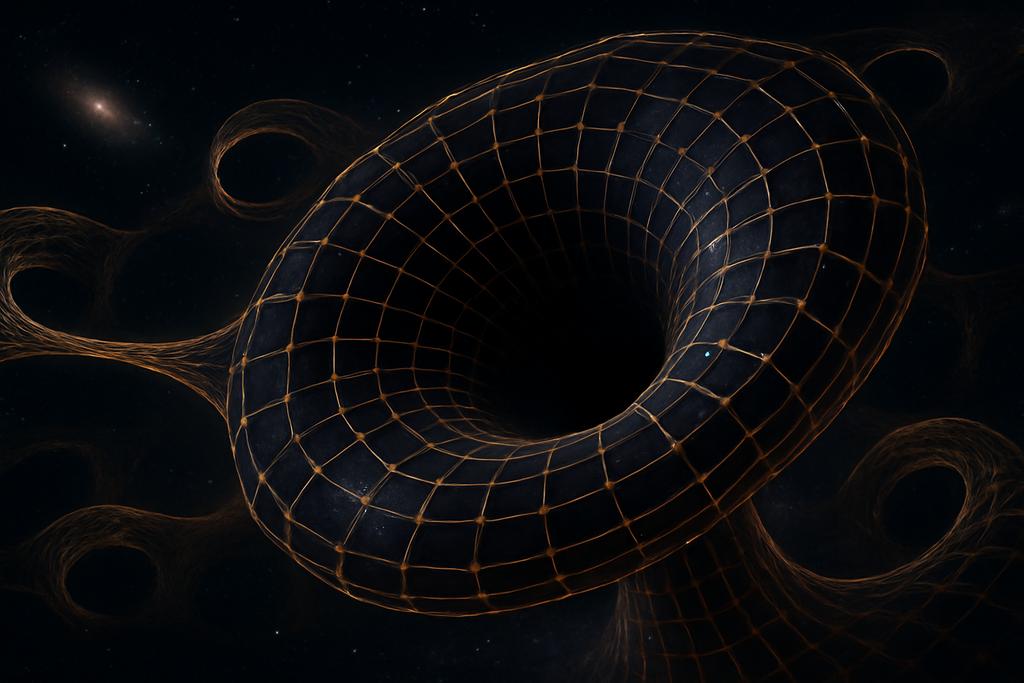Summing the Shapes of Space
In the quest to understand quantum gravity—the elusive theory that would unite Einstein’s curved spacetime with the quantum world—physicists have long toyed with a wild idea: what if the fabric of the universe isn’t fixed, but constantly changing its shape? Imagine not just particles and fields fluctuating, but the very topology of space itself shifting, with baby universes budding off and wormholes connecting distant realms.
This “sum over topologies” is a tantalizing but notoriously difficult concept. The set of all possible three-dimensional shapes (3-manifolds) is vast and complicated, and summing over them to define a quantum gravity path integral is a mathematical nightmare. The problem is twofold: classifying these shapes is hard, and even if you could, the sum tends to diverge wildly.
Enter Thomas Nicosanti and Pavel Putrov from SISSA and ICTP in Trieste, Italy, who have crafted a clever new approach to this problem. They focus on a simplified model of 3D quantum gravity, where the gravitational path integral is replaced by a sum over topological quantum field theories (TQFTs)—mathematical gadgets that assign numbers to shapes in a way that depends only on their topology, not on any geometric details.
Specifically, they consider abelian TQFTs, which are among the simplest but still rich enough to capture interesting physics. These theories assign partition functions to 3-manifolds with boundaries, and crucially, these partition functions depend only on algebraic invariants of the manifold—its first homology group and associated linking forms. This insight allows the authors to translate the daunting sum over all 3D shapes into a sum over algebraic data: finitely generated abelian groups equipped with bilinear forms and maps.
From Shapes to Algebra: The Magic of Homology
Homology groups are like the DNA of a shape, capturing its essential holes and twists. For a 3-manifold, the first homology group counts loops that cannot be shrunk to a point, encoding the manifold’s fundamental topology. The linking form measures how these loops intertwine.
Nicosanti and Putrov show that the partition function of their abelian TQFT depends only on this algebraic data, not on the manifold’s complicated geometric details. This remarkable reduction means that instead of wrestling with an infinite zoo of 3D shapes, one can sum over a well-understood class of algebraic objects.
But the sum still needs to be tamed. The authors introduce a measure—a way to weight each algebraic object—that ensures the sum converges. They find explicit bounds on this measure, showing it must decay fast enough with the complexity of the group and its torsion part.
Wormholes, Factorization, and the Ensemble Mystery
One of the most striking consequences of summing over topologies is the breakdown of a cherished property in quantum field theory: factorization. Normally, the partition function of two disconnected spaces is just the product of their individual partition functions. But when wormholes—topological tunnels connecting separate universes—are included, this neat factorization fails.
This failure has profound implications for holography, the principle that a gravitational theory in a bulk space can be described by a lower-dimensional theory on its boundary. The authors argue that the bulk 3D quantum gravity with summed topologies is not dual to a single 2D boundary theory, but rather to an ensemble of 2D topological quantum field theories. In other words, the boundary theory is a statistical mixture, a probability distribution over many possible 2D theories.
This ensemble interpretation elegantly explains the wormhole-induced factorization failure: averaging over many boundary theories naturally produces correlations that mimic wormholes in the bulk.
Decoding the Ensemble: Moments, Distributions, and Bell Polynomials
To characterize this ensemble, the authors delve into the mathematics of 2D TQFTs, which correspond to commutative Frobenius algebras. The partition function on a genus-g surface is a sum over algebraic data raised to powers depending on g.
They introduce random variables representing the dimension of the boundary Hilbert space and the weights of these algebraic components. The “abelian condition”—reflecting the bulk theory’s abelian nature—imposes intricate constraints on the joint distribution of these variables.
Using combinatorial tools like Bell polynomials and moment-generating functions, Nicosanti and Putrov solve these constraints, revealing a rich structure of correlations in the ensemble. Notably, they show that the dimension and weights cannot be independent random variables if the abelian condition is to hold, ruling out naive factorization of the ensemble.
Prime Factorization of Topology and Explicit Examples
Thanks to the classification of finite abelian groups and bilinear forms, the authors exploit prime decomposition to factorize the sum over algebraic data into independent sums over p-groups for each prime p. This prime-by-prime analysis simplifies computations and clarifies the structure of the ensemble.
They work out explicit formulas for untwisted and twisted Dijkgraaf-Witten theories—well-known classes of TQFTs with finite gauge groups—and compute the gravitational partition functions with various topological boundary conditions. These examples showcase the power of their approach and hint at a deep interplay between algebra, topology, and quantum gravity.
Why This Matters
This work illuminates a path through the thicket of quantum gravity’s sum over topologies, offering a mathematically rigorous and physically insightful framework. By translating the problem into algebraic terms and embracing the ensemble nature of the holographic dual, it reconciles wormhole physics with boundary theory factorization in a novel way.
Beyond pure theory, these ideas resonate with recent developments in quantum gravity, black hole physics, and quantum information, where ensemble averages and wormholes have emerged as central themes. The paper by Nicosanti and Putrov thus contributes a vital piece to the puzzle of how spacetime geometry, quantum mechanics, and topology intertwine.
Looking Ahead
Their approach opens avenues for exploring more general TQFTs, including non-abelian and fermionic cases, and for connecting with physical models of quantum gravity in higher dimensions. It also suggests new perspectives on the role of topology change, baby universes, and the statistical nature of holographic dualities.
In the end, the sum over shapes is not just a mathematical curiosity—it may be the key to understanding the quantum fabric of reality itself.










